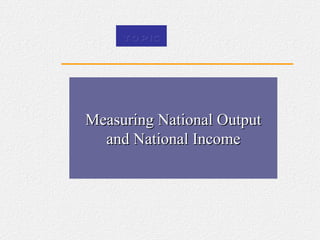
Presentation 2 national income
- 1. Measuring National Output and National Income
- 8. Value Added Value Added in the Production of an Automobile Stage Of Production Value at End of Each Stage of Production Value Added by Each Stage of Production (1) Iron and other raw materials $ 600 $ 600 (2) Pig iron and other processed materials 1,200 600 (3) Steel ingots, etc 2,400 1,200 (4) Sheet steel, etc 5,500 3,100 (5) (6) (7) Automobile parts Assembly Automobile delivered at showroom 8,000 11,500 16,900 46,100 2,500 3,500 5,400 16,900
- 11. The circular flow of income: The inner flow Firms Households Factor Services Goods and services Price of goods and services Factor payments
- 12. Factor payments Consumption of domestically produced goods and services (C d ) The circular flow of income WITHDRAWALS INJECTIONS Investment ( I ) Government expenditure ( G ) Export expenditure ( X ) BANKS, etc Net saving ( S ) GOV. Net taxes ( T ) ABROAD Import expenditure ( M )
- 14. The Income Approach Components of GDP, 1999: The Income Approach BILLIONS OF DOLLARS PERCENTAGE OF GDP Gross domestic product 9,299.2 100.0 National income 7,469.7 80.3 Compensation of employees 5,299.8 57.0 Proprietors’ income 663.5 7.1 Corporate profits 856.0 9.2 Net interest 507.1 5.5 Rental income 143.4 1.5 Depreciation 1,161.0 12.5 Indirect taxes minus subsidies 689.7 7.4 Net factor payments to the rest of the world 11.0 0.1 Other 32.2 0.3 Source: See Table 17.2.
- 15. From GDP to Disposable Income GDP, GNP, NNP, National Income, Personal Income, and Disposable Personal Income, 1999 DOLLARS (BILLIONS) GDP 9,299.2 Plus: receipts of factor income from the rest of the world + 305.9 Less: payments of factor income to the rest of the world 316.9 Equals: GNP 9,288.2 Less: depreciation (capital consumption allowance) 1,161.0 Equals: net national product (NNP) 8,127.1 Less: indirect taxes minus subsidies plus other 675.5 Equals: national income 7,469.7 Less: Undistributed profits 485.7 Less: social insurance payments 662.1 Plus: personal interest income received from the government and consumers + 456.6 Plus: transfer payments to persons +1,011.0 Equals: personal income 7,789.6 Less: personal taxes 1,152.0 Equals: disposable personal income 6,637.7 Source: See Table 17.2.
- 18. National income accounting: a summary GNP (and GNI) at market prices GDP at market prices NYA C X - Z I NYA G NNP at market prices Deprec'n National Income or NNP at factor cost Net Indirect taxes Wages and salaries Self- employment Profits, rents
- 20. From Disposable Personal Income to Personal Saving Personal Consumption Exp. = PDI – Personal savings Personal Savings = PDI – Personal Consumption Exp. Disposable Personal Income and Personal Saving, 1999 DOLLARS (BILLIONS) Disposable personal income 6,637.7 Less: Personal consumption expenditures 6,268.7 Interest paid by consumers to business 194.8 Personal transfer payments to foreigners 26.6 Equals: personal saving 147.6 Personal savings as a percentage of disposable personal income: 2.2% Source: See Table 17.2.
- 23. GDP Plus: receipts of factor income from the rest of the world Less: payments of factor income to the rest of the world Equals: GNP Less: depreciation (capital consumption allowance) Equals: net national product (NNP) Less: indirect taxes minus subsidies plus other Equals: national income (NNP at factor cost) Less: Undistributed profits Less: social security payments Plus: personal interest income received from the government and consumers Plus: transfer payments to persons Equals: personal income Less: personal taxes (Income tax, wealth tax, etc) Equals: disposable personal income Less Personal consumption expenditures Interest paid by consumers to business Personal transfer payments to foreigners Equals: personal saving
- 38. The Circular Flow Goods Other countries Financial markets Government Firms (production) Household Taxes Factor services Savings Imports Government Spending Wages, rents, interest, profits Exports Investment Personal consumption
- 41. Calculating Real GDP A Three-Good Economy (1) (2) (3) (4) (5) (6) (7) (8) GDP IN GDP IN GDP IN GDP IN YEAR 1 YEAR 2 YEAR 1 YEAR 2 IN IN IN IN PRODUCTION PRICE PER UNIT CURRENT YEAR YEAR 1 YEAR 2 CURRENT YEAR YEAR 1 YEAR 2 YEAR 1 YEAR 2 PRICES PRICES PRICES PRICES Q 1 Q 2 P 1 P 2 P 1 x Q 1 P 1 x Q 2 P 2 x Q 1 P 2 X Q 2 Good A 6 11 $.50 $ .40 $3.00 $5.50 $2.40 $4.40 Good B 7 4 .30 1.00 2.10 1.20 7.00 4.00 Good C 10 12 .70 .90 7.00 8.40 9.00 10.80 Total $12.10 $15.10 $18.40 $19.20 Nominal GDP in year 1 Nominal GDP in year 2
- 42. Exhibit 3: A Price Index (base year = 2000) Price of Bread Price of Bread in Current Year in Base Year Price Index Year (1) (2) (3) = (1)/(2)x100 2000 $1.25 $1.25 100 2001 1.30 1.25 104 2002 1.40 1.25 112 For base year 2000, we divide the base price of bread by itself, $1.25 / $1.25 price index for 2000 equals 1 100 = 100 the price index in the base year is always 100. The price index for 2001 is $1.30 / $1.25 = 1.04, which when multiplied by 100 = 104, and for 2002 it is 112. Thus, the index is 4% higher in 2001 than in the base year, and 12% higher in 2002 than in the base year.
Editor's Notes
- See Figure 20-5 in the main text. Animation provides one block at a time from the left.
- Disposable personal income or after-tax income equals personal income minus personal income taxes. Personal saving is the amount of disposable income that is left after total personal spending in a given period.
- The relationship between total production and total sales is: GDP = final sales + change in business inventories
- The relationship between total production and total sales is: GDP = final sales + change in business inventories
